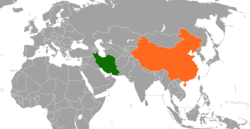Sino-Persian relations
 | |
Iran |
China |
|---|---|
Iran-China relations (Chinese: 中伊关系, Pinyin: Zhōng-Yī guānxì), or Sino-Iran relations, date back over many centuries. In pre-Islamic times, the Parthians and Sassanids had various contacts with China, and in Islamic times, they were connected via the Silk Road.
Relations during the Parthian era

The Chinese explorer Zhang Qian, who visited the neighbouring countries of Bactria and Sogdiana in 126 BCE, made the first known Chinese report on Parthia. In his accounts Parthia is named "Ānxī" (Chinese: 安息), a transliteration of "Arsacid", the name of the Parthian dynasty. Zhang Qian clearly identifies Parthia as an advanced urban civilization, which he equates to those of Dayuan (in Ferghana) and Daxia (in Bactria).
- "Anxi is situated several thousand li west of the region of the Great Yuezhi (in Transoxonia). The people are settled on the land, cultivating the fields and growing rice and wheat. They also make wine out of grapes. They have walled cities like the people of Dayuan (Ferghana), the region contains several hundred cities of various sizes. The coins of the country are made of silver and bear the face of the king. When the king dies, the currency is immediately changed and new coins issued with the face of his successor. The people keep records by writing on horizontal strips of leather. To the west lies Tiaozi (Mesopotamia) and to the north Yancai and Lixuan (Hyrcania)." (Shiji, 123, Zhang Qian quote, trans. Burton Watson).
Following Zhang Qian's embassy and report, commercial relations between China, Central Asia, and Parthia flourished, as many Chinese missions were sent throughout the 1st century BCE: "The largest of these embassies to foreign states numbered several hundred persons, while even the smaller parties included over 100 members... In the course of one year anywhere from five to six to over ten parties would be sent out." (Shiji, trans. Burton Watson).
The Parthians were apparently very intent on maintaining good relations with China and also sent their own embassies, starting around 110 BC: "When the Han envoy first visited the kingdom of Anxi (Parthia), the king of Anxi dispatched a party of 20,000 horsemen to meet them on the eastern border of the kingdom... When the Han envoys set out again to return to China, the king of Anxi dispatched envoys of his own to accompany them... The emperor was delighted at this." (Shiji, 123, trans. Burton Watson).
In 97 CE the Chinese general Ban Chao went as far west as the Caspian Sea with 70,000 men and established direct military contacts with the Parthian Empire.
Parthians also played a role in the Silk Road transmission of Buddhism from Central Asia to China. An Shih Kao, a Parthian nobleman and Buddhist missionary, went to the Chinese capital Luoyang in 148 CE where he established temples and became the first man to translate Buddhist scriptures into Chinese.
Relations today
Trade relations
The People's Republic of China finds Iran as a permanent source for its exports and growing energy demand. In March 2004, Zhuhai Zhenrong Corporation, a Chinese state-run company, signed a 25-year contract to import 110 million metric tons of Liquefied Natural Gas (LNG) from Iran. [1] This was followed by another contract between Sinopec and Iran, signed in October of the same year. The deal worth $100 billion, adds an extra 250 million tons of LNG to China's energy supply, extracted from Iran's Yadavaran field over a 25-year period.
In 2001, Iran-China trade volume stood at $3.3 Billion. [2]
Ali Akbar Saheli, Iran's former representative to the International Atomic Energy Agency said that the two countries "mutually complement each other. They have industry and we have energy resources". [3]
Political relations
Iran today continues to align itself politically with the People's Republic of China as the European Union and United States push forward with policies to isolate Iran both politically and economically. Iran has observer status (and aspires membership to) the Shanghai Cooperation Organization, in which China has a leading role.
In July 2004, Iranian parliamentary speaker Gholam Ali Haddad-Adel stressed China's support for the Iranian nuclear programs. [4] China's Foreign Minister, Li Zhaoxing also said that his country opposes Iran being referred to United Nations Security Council over its nuclear programme, and claimed that the Iranian government had a very positive attitude in its cooperation with the IAEA. [5]
See also
- Foreign relations of imperial China
- Foreign relations of the People's Republic of China
- Foreign relations of Iran
- An Shihkao
- Iran-Russia relations
- US-Iran relations
- Pirooz
External links
historical
- "Iran in Central Asia"
- The Sassanids in China
- For more on Iranian-Chinese relations in history see E.I. p.424-460.
